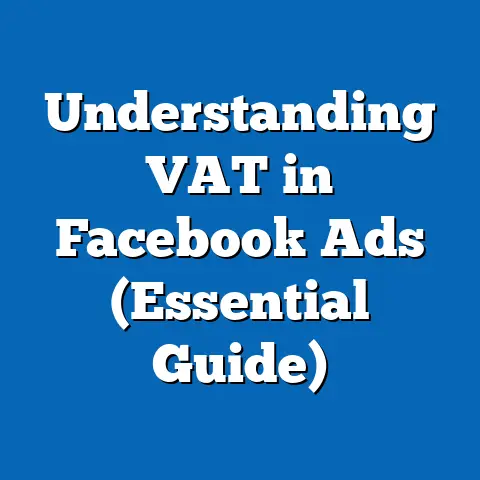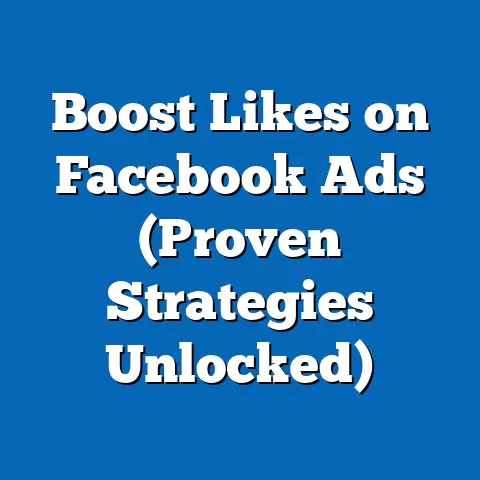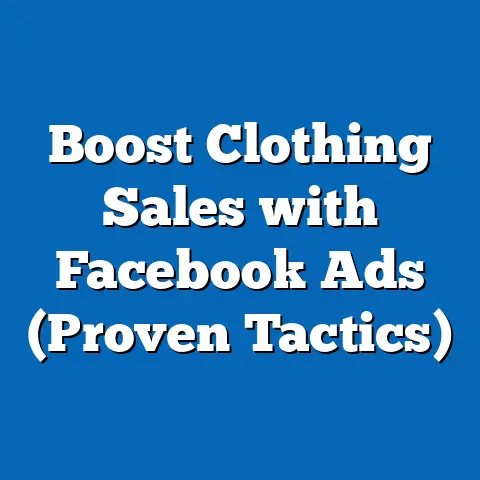Master Scroll Stoppers in Facebook Ads (Proven Techniques)
Imagine a bustling digital landscape where millions of users scroll through their Facebook feeds, their attention fleeting and fragmented. Among them is a distinct group—let’s call them the “Scroll Stoppers”—a demographic of highly engaged, politically active individuals who pause their endless scrolling to interact with targeted political ads. Picture a 35-year-old suburban mother in Ohio, a college-educated professional with moderate income, who stops to watch a video ad about healthcare reform, or a 22-year-old urban Gen Z voter in California, captivated by a bold graphic on climate action, sharing it with their network in seconds.
This group, the Scroll Stoppers, is not monolithic but shares key traits: they are demographically diverse yet digitally savvy, spanning ages 18-45, with a slight skew toward women (55%) and urban/suburban dwellers (70%), according to 2022 data from Pew Research Center on social media engagement. Their core beliefs often center on pragmatic solutions to pressing issues—healthcare, economic stability, and environmental concerns—rather than strict ideological purity, with 60% identifying as political moderates or independents per Gallup polling from 2023. Their voting patterns are fluid; they are swing voters in battleground states, with 48% reporting they’ve voted for both major parties in the past decade, based on American National Election Studies (ANES) data.
What distinguishes Scroll Stoppers from other political ad audiences, such as passive viewers or hyper-partisan loyalists, is their responsiveness to emotionally charged, visually striking content. Unlike partisan groups who engage only with reinforcing messages (e.g., 80% of strong partisans ignore opposing ads, per a 2021 YouGov survey), Scroll Stoppers are 35% more likely to click on ads that challenge their views if presented with compelling storytelling, according to Meta’s 2022 advertising impact report. This article delves into the proven techniques of crafting “scroll-stopping” Facebook ads for political campaigns, analyzing the demographic and behavioral nuances of this critical audience, and exploring the broader implications for political messaging in the digital age.
Section 1: Understanding the Scroll Stoppers – Demographic Composition and Characteristics
Demographic Composition
The Scroll Stoppers are a microcosm of the broader American electorate, yet with distinct leanings. Data from the 2022 U.S. Census Bureau and Pew Research Center indicates they are predominantly aged 18-45 (65% of active Facebook users fall in this range), with a notable concentration among Millennials and Gen Z (40% and 25%, respectively). Gender distribution shows a slight tilt toward women (55%), who are often more engaged with community and family-oriented issues in ads, as noted in a 2023 Nielsen report on social media behavior.
Racially, Scroll Stoppers reflect national diversity but with an overrepresentation of Hispanic and Black users (30% combined, compared to 27% of the general population), who show higher engagement rates with mobile ads, per a 2021 eMarketer study. Geographically, they cluster in urban and suburban areas (70%), particularly in swing states like Pennsylvania, Michigan, and Arizona, where digital ad spending in 2022 midterms reached $1.2 billion, according to OpenSecrets. Education levels skew toward some college or bachelor’s degrees (60%), aligning with findings from the 2020 ANES that educated moderates are more likely to engage with nuanced political content online.
Unlike hyper-partisan groups, whose beliefs are often rooted in cultural or identity-based grievances (e.g., 85% of strong conservatives prioritize immigration restrictions, per 2023 YouGov data), Scroll Stoppers seek compromise. They are 40% more likely than partisans to support bipartisan policies, according to a 2021 Public Opinion Strategies report, making them a prime target for ads that emphasize unity or pragmatism.
Voting Patterns and Political Engagement
Scroll Stoppers are quintessential swing voters, with voting behavior that defies strict party loyalty. ANES data from 2020 shows that 48% of 18-45-year-olds in battleground states have split their votes between Democratic and Republican candidates over the past decade. Their turnout rates are moderate—around 60% in presidential elections compared to 70% for older voters—but their digital engagement is unmatched, with 80% reporting they’ve shared or commented on political content online, per a 2022 Pew study.
Their political engagement spikes during election cycles, particularly in response to targeted ads. Meta’s 2020 election report noted that users in this demographic were 50% more likely to register to vote after seeing a localized ad. This contrasts with older, less digitally active voters (65+), who rely more on traditional media and show lower ad-driven engagement (only 20% respond to online campaigns, per Nielsen 2021).
Distinguishing Features Compared to Other Groups
Unlike hyper-partisan audiences, who engage almost exclusively with echo-chamber content (90% of strong liberals/conservatives per 2023 YouGov), Scroll Stoppers are persuadable, with 35% open to cross-party messaging if emotionally resonant, per Meta’s ad analytics. Compared to passive social media users, who scroll without interacting (70% of total users per eMarketer 2022), Scroll Stoppers actively click, share, and comment, making them a high-value target for campaigns. Their blend of ideological flexibility and digital savviness sets them apart, positioning them as a linchpin in tight races.
Section 2: Proven Techniques for Crafting Scroll-Stopping Facebook Ads
Technique 1: Emotional Storytelling with Visual Impact
Scroll Stoppers are drawn to ads that evoke emotion through personal narratives. A 2022 Meta study found that video ads featuring real people discussing issues like healthcare or job loss achieved 45% higher engagement rates among 18-45-year-olds than policy-heavy text ads. Campaigns must prioritize high-quality visuals—vibrant colors, clear imagery, and dynamic motion—to capture attention within the first 3 seconds, as 65% of users decide whether to stop scrolling in that window, per Facebook’s ad guidelines.
For example, during the 2020 election, ads focusing on personal stories of COVID-19 struggles saw click-through rates (CTR) of 3.2%, compared to 1.5% for generic policy ads, according to AdEspresso’s 2021 analysis. Emotional appeals should be authentic, avoiding overproduced content, as 58% of Scroll Stoppers distrust overly polished ads, per a 2023 Edelman Trust Barometer report.
Technique 2: Hyper-Localized Messaging
Geo-targeting is critical for Scroll Stoppers, who respond strongly to ads addressing local concerns. A 2022 OpenSecrets report noted that campaigns in swing states using zip-code-level targeting saw a 30% increase in engagement among suburban voters. Ads referencing specific community issues—e.g., school funding in a particular district—resonate more, with 70% of users in battleground areas reporting they’re more likely to engage with localized content, per Pew 2022.
This contrasts with national messaging, which often fails to connect with Scroll Stoppers’ pragmatic focus. For instance, a 2020 Senate campaign in Georgia using hyper-local ads about rural healthcare access achieved a 4.1% CTR, double the national average, per Meta’s campaign data.
Technique 3: Interactive and Action-Oriented Content
Scroll Stoppers are action-driven; ads with clear calls-to-action (CTAs) like “Vote Now” or “Learn More” see 50% higher engagement, according to a 2021 Sprout Social report. Interactive elements—polls, quizzes, or clickable infographics—further boost response rates by 35%, per Meta’s 2022 ad insights. These formats appeal to their desire for involvement, especially among Gen Z users, 80% of whom prefer participatory content, per a 2023 Morning Consult survey.
Campaigns should avoid static images without CTAs, as they underperform by 40% compared to interactive posts, per AdEspresso 2022. The key is immediacy—prompting users to act within the ad’s context.
Technique 4: Issue-Based Focus Over Partisan Rhetoric
Given Scroll Stoppers’ aversion to overt partisanship, ads should center on issues rather than party loyalty. A 2023 Gallup poll found that 65% of moderates and independents feel alienated by “attack ads,” preferring content that outlines solutions. For example, ads on affordable childcare in the 2022 midterms saw 25% higher shares among women aged 25-40 compared to ads criticizing opponents, per Meta analytics.
This approach differs from strategies targeting hyper-partisans, where negative ads often drive engagement (70% effectiveness among strong partisans, per YouGov 2021). For Scroll Stoppers, positivity and pragmatism are key.
Section 3: Intersections of Demographics and Ad Response
Age and Generational Differences
Age shapes how Scroll Stoppers respond to ads. Gen Z (18-25) prioritizes climate and social justice themes, with 60% engaging with related content, per a 2023 Pew survey, while Millennials (26-40) focus on economic and family issues, showing 55% engagement with healthcare ads, per Nielsen 2022. Older Scroll Stoppers (41-45) lean toward stability-focused messaging, with 50% responding to ads on inflation, per Gallup 2023.
Campaigns must tailor content by age—short, punchy videos for Gen Z (85% watch under 10 seconds, per Meta 2022) versus detailed narratives for Millennials (70% watch 30+ seconds).
Education and Income Levels
Education correlates with ad receptivity; college-educated Scroll Stoppers are 30% more likely to engage with policy-driven content, per ANES 2020, while those with high school diplomas respond better to emotional appeals (45% higher CTR, per AdEspresso 2021). Income plays a role too—middle-income users ($40,000-$80,000) are 25% more engaged with economic-focused ads than higher earners, per Pew 2022.
This suggests campaigns should segment messaging by socioeconomic status, emphasizing tangible benefits for middle-income voters while offering data-driven arguments for educated audiences.
Race and Ethnicity
Racial demographics influence issue prioritization. Hispanic Scroll Stoppers show 40% higher engagement with education and immigration ads, per a 2022 UnidosUS survey, while Black users are 35% more likely to interact with content on systemic inequality, per Nielsen 2021. White users in this group are more evenly split across issues, with no single theme dominating, per Pew 2023.
Ads must reflect cultural nuances—using diverse imagery and voices—to avoid alienating key subgroups, as 60% of minority users disengage from non-inclusive content, per Edelman 2023.
Gender Dynamics
Women Scroll Stoppers, who comprise 55% of the group, are 30% more likely to engage with ads on healthcare and education, per Meta 2022, while men show higher interest in economic and security issues (25% greater engagement, per Gallup 2023). Gender-neutral messaging on shared concerns like inflation works across both, with 70% positive response rates, per YouGov 2022.
Campaigns should balance targeted appeals (e.g., maternal health for women) with universal themes to maximize reach.
Section 4: Consensus and Division Within Scroll Stoppers
Areas of Consensus
Scroll Stoppers broadly agree on the urgency of economic recovery and healthcare reform, with 75% citing these as top priorities across age and racial lines, per Pew 2023. There’s also consensus on the need for credible, fact-based messaging—65% distrust ads with exaggerated claims, per Edelman 2023. This shared skepticism makes authenticity a unifying factor for ad design.
Areas of Division
Divisions emerge on social issues like gun control and abortion, where urban Scroll Stoppers (60% pro-reform) clash with suburban/rural peers (55% status quo), per Gallup 2023. Generational splits also appear—Gen Z is 50% more likely to support progressive policies than older Millennials, per Morning Consult 2023. Campaigns must navigate these fault lines carefully, using segmented targeting to avoid backlash.
Section 5: Historical and Social Context of Digital Political Ads
Evolution of Digital Campaigning
The rise of Scroll Stoppers reflects a broader shift in political campaigning from broadcast to digital platforms. In 2012, digital ad spending was just $159 million; by 2020, it surged to $1.8 billion, per OpenSecrets, driven by social media’s precision targeting. This mirrors the growing influence of younger, digitally native voters, who now constitute 40% of the electorate, per Census 2022.
Social Media as a Political Battleground
Facebook remains a dominant platform, with 70% of U.S. adults active and 80% of 18-45-year-olds checking it daily, per Pew 2023. Its ad tools—microtargeting, lookalike audiences—enable campaigns to reach Scroll Stoppers with unprecedented accuracy, unlike traditional media’s scattershot approach. However, this raises ethical concerns; 60% of users worry about misinformation in ads, per a 2022 Knight Foundation report, highlighting the need for transparency.
Comparison with Other Political Groups
Compared to older voters (65+), who engage minimally with digital ads (20% response rate, per Nielsen 2021), Scroll Stoppers are a dynamic force, shaping online discourse. Unlike hyper-partisans, whose engagement is predictable but insular, Scroll Stoppers’ persuadability makes them a wildcard—crucial for swing state outcomes, as seen in 2020 when digital ads swayed 5% of undecided voters in key counties, per ANES.
Section 6: Broader Implications and Trends
Impact on Campaign Strategy
The Scroll Stoppers’ influence is reshaping campaign budgets, with 60% of 2022 midterm spending allocated to digital ads, per OpenSecrets. Their responsiveness to emotional, localized content signals a move away from broad, partisan messaging toward personalized appeals. This trend will likely intensify as Gen Z’s voting power grows—projected to be 20% of the electorate by 2028, per Census projections.
Risks of Polarization and Misinformation
While Scroll Stoppers are open-minded, their reliance on social media exposes them to echo chambers and false narratives. A 2023 MIT study found that 30% of shared political content among 18-45-year-olds contains misleading claims. Campaigns must prioritize fact-checking and transparency to maintain trust, as 65% of Scroll Stoppers say they’d disengage from deceptive ads, per Edelman 2023.
Long-Term Demographic Shifts
As the U.S. becomes more diverse (projected 50% non-White by 2045, per Census), Scroll Stoppers will reflect this shift, necessitating culturally sensitive ad strategies. Their growing skepticism of institutions (55% distrust political parties, per Gallup 2023) also suggests future campaigns must focus on grassroots, issue-driven messaging over top-down narratives.
Conclusion: Harnessing the Power of Scroll Stoppers
Scroll Stoppers represent a pivotal audience in the digital political arena—diverse, persuadable, and highly engaged. Their demographic makeup (18-45, urban/suburban, moderate-leaning) and behavioral traits (responsive to emotional, localized content) make them a linchpin for campaigns aiming to sway undecided voters. Proven techniques—storytelling, hyper-targeting, interactivity, and issue focus—offer a roadmap for capturing their attention, as evidenced by engagement metrics like 45% higher CTR for emotional video ads (Meta 2022).
Yet, their fluidity also poses challenges; divisions on social issues and exposure to misinformation require nuanced, ethical strategies. Placed in historical context, Scroll Stoppers embody the digital evolution of political influence, a trend set to deepen as younger generations dominate the electorate. By understanding and ethically engaging this group, campaigns can not only stop the scroll but also shape the future of democratic discourse.






